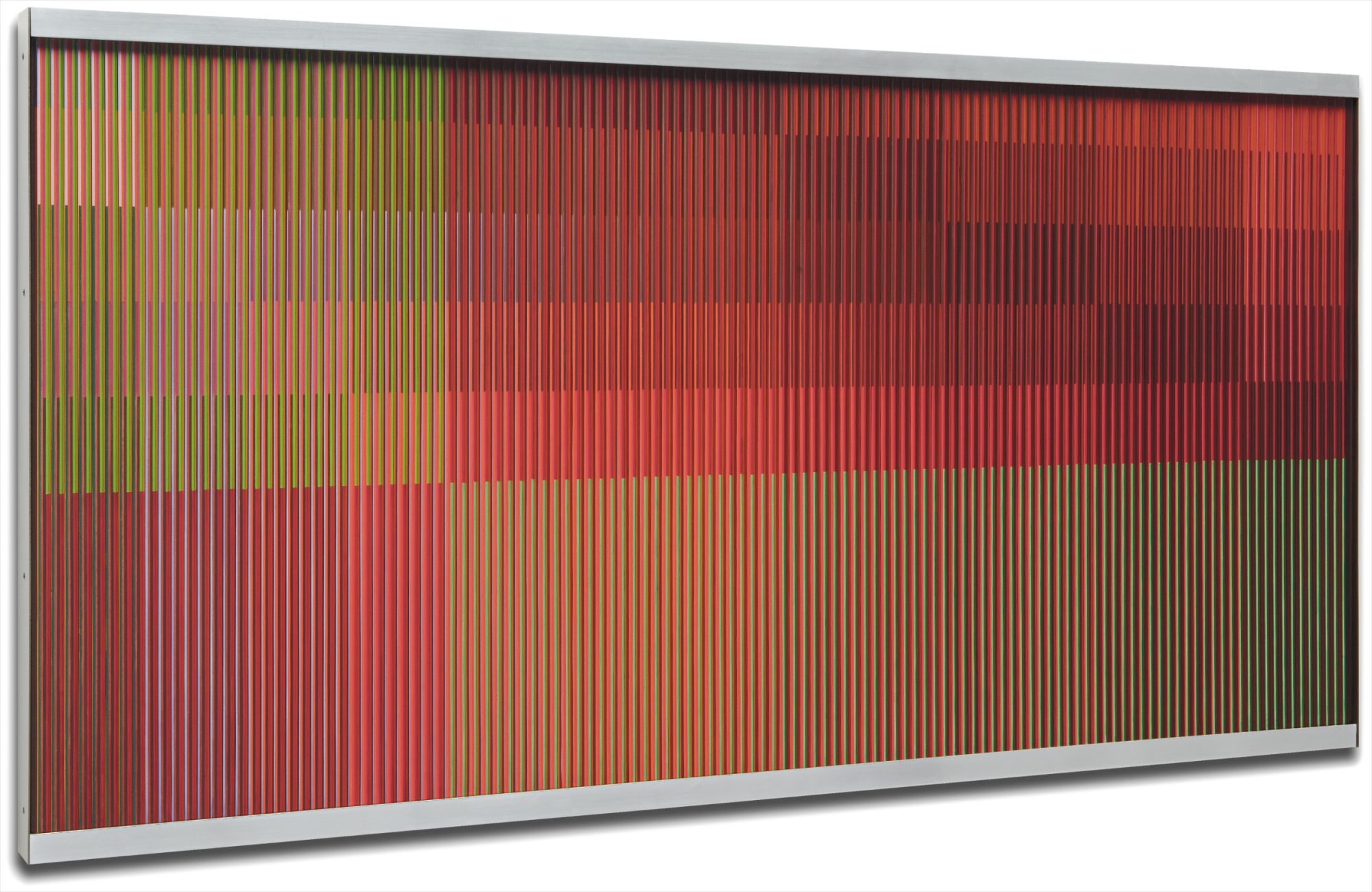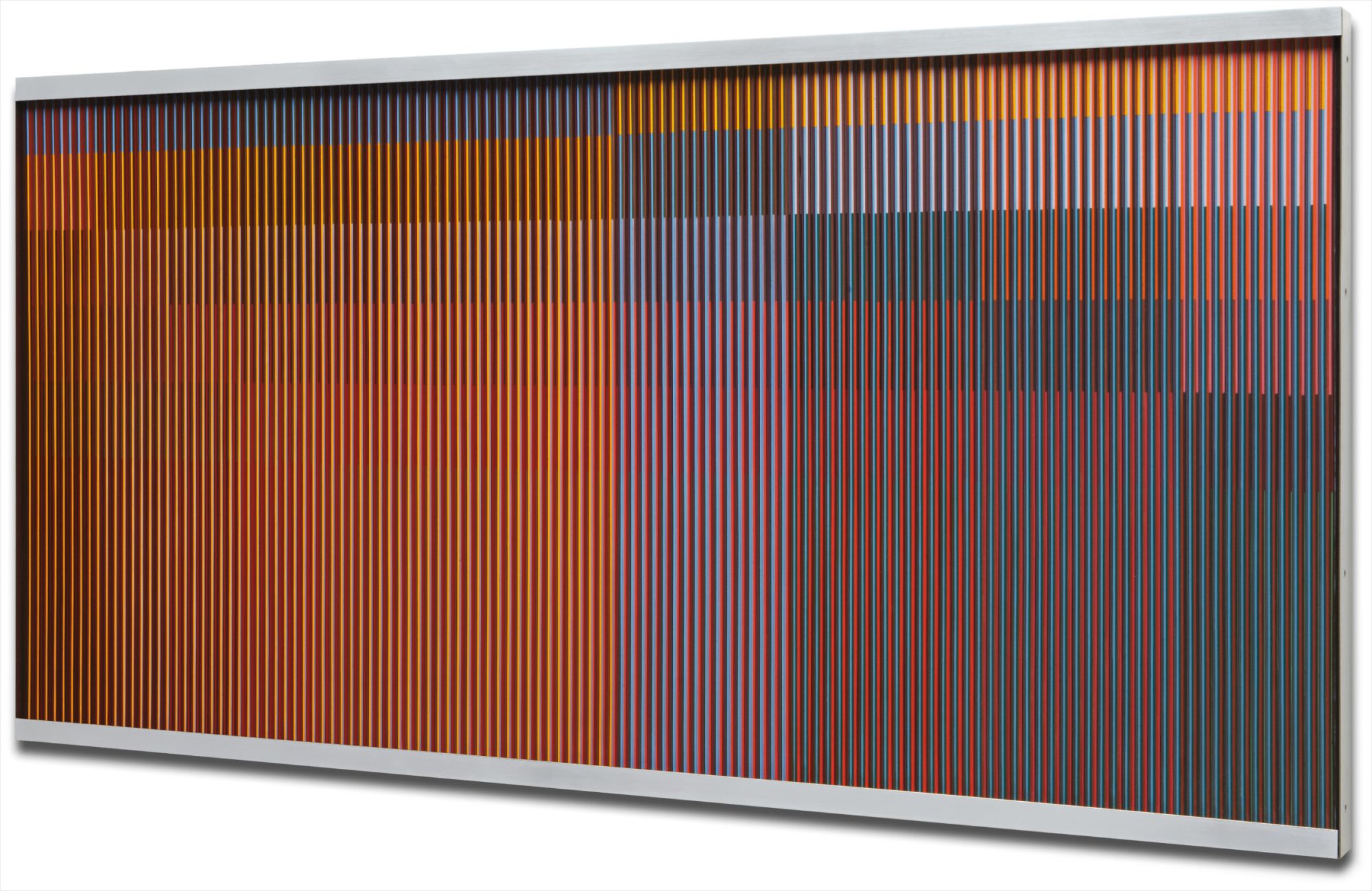





18
Carlos Cruz-Diez
Physichromie No. 651
1973
acrylic and laminated plastic strips, mounted on wood panel with aluminum strip frame
27 3/4 x 53 3/4 x 2 in. (70.5 x 136.5 x 5.1 cm.)
Signed, titled, initialed, inscribed and dated "Physichromie No. 651 Cruz-Diez Paris Avril 1973 C.D." on the reverse.
Full-Cataloguing
A pioneer in developing color theory and practice, Venezuelan artist Carlos Cruz-Diez began his extensive studies in the physical properties of color in the 1950s and 1960s. He was a key participant in lively discussion groups alongside Jesús Rafael Soto and Alejandro Otero, which formed the basis of the Venezuelan Kinetic Art movement. Towards the end of 1956, after two visits to Paris, Cruz-Diez honed in on the instability of flat surfaces, seeking to create visual effects through the physical interaction of colors. This was initially centered on abstract organic shapes, but quickly developed into his characteristic uniform geometric patterns. Specifically, Cruz-Diez was interested in the interplay of light and color upon varied surfaces, and the dissociation of the traditional binomial of color– form. Indeed, the artist’s intention was to set color free from form, stating “color is an autonomous reality, devoid of anecdotes, that evolves in real time and space with no need of form or support”.
Cruz-Diez’s studies were furthered when the artist came across articles written by Edwin Land, the inventor of the Polaroid camera, which looked at the configuration of the entire color spectrum through combinations of red and green monochromes. This was a key factor in the development of the first Physichromie series in 1959, which subsequently evolved from a limited palette of solely red and green to a much vivid interplay of colors, as seen in the present lot, Physichromie No. 651 from 1973. The term “Physichromie” that he used to title these creations is a neologism coined by the artist, which he derived from the scientific term “physical chromatism”. Indeed, the Cruz-Diez Foundation defines a “Physichromie” as a “light trap in a space where a series of color frames interact; frames that transform each other, generating new ranges of colors not present on the support.”
Executed in 1973, the present lot is emblematic of Cruz-Diez’s restless experimentation in visual dynamics and his intent to test the boundaries of perception and the spatial elements of our reality. The artist aims to enhance our experience of color and address how it is configured by its supporting space. When facing the work, the viewer is able to visualize the complete color spectrum despite the fact that not all the individual colors are physically represented in the work itself. This chromatic spectrum evolves depending on the movement of the viewer and the intensity of the light. In this sense, the work is presented as a physical embodiment of color, a space where colored parallel strips interact with angles of refraction, structured in a very specific manner so that they blend in the spectator’s vision, thereby changing the work’s appearance as the spectator moves. The effect is that of a blurred boundary between the work’s reality and the viewer’s perception, creating a unique relationship that enhances our individual interaction with the work. Indeed, Cruz-Diez’s body of work powerfully expands the possibilities of art by redefining art’s relationship to its viewer. Rejecting the conventional model of passive contemplation, Cruz-Diez seeks to involve the viewer as an active participant, a necessary component to the completion of his work.
Cruz-Diez’s studies were furthered when the artist came across articles written by Edwin Land, the inventor of the Polaroid camera, which looked at the configuration of the entire color spectrum through combinations of red and green monochromes. This was a key factor in the development of the first Physichromie series in 1959, which subsequently evolved from a limited palette of solely red and green to a much vivid interplay of colors, as seen in the present lot, Physichromie No. 651 from 1973. The term “Physichromie” that he used to title these creations is a neologism coined by the artist, which he derived from the scientific term “physical chromatism”. Indeed, the Cruz-Diez Foundation defines a “Physichromie” as a “light trap in a space where a series of color frames interact; frames that transform each other, generating new ranges of colors not present on the support.”
Executed in 1973, the present lot is emblematic of Cruz-Diez’s restless experimentation in visual dynamics and his intent to test the boundaries of perception and the spatial elements of our reality. The artist aims to enhance our experience of color and address how it is configured by its supporting space. When facing the work, the viewer is able to visualize the complete color spectrum despite the fact that not all the individual colors are physically represented in the work itself. This chromatic spectrum evolves depending on the movement of the viewer and the intensity of the light. In this sense, the work is presented as a physical embodiment of color, a space where colored parallel strips interact with angles of refraction, structured in a very specific manner so that they blend in the spectator’s vision, thereby changing the work’s appearance as the spectator moves. The effect is that of a blurred boundary between the work’s reality and the viewer’s perception, creating a unique relationship that enhances our individual interaction with the work. Indeed, Cruz-Diez’s body of work powerfully expands the possibilities of art by redefining art’s relationship to its viewer. Rejecting the conventional model of passive contemplation, Cruz-Diez seeks to involve the viewer as an active participant, a necessary component to the completion of his work.
Carlos Cruz-Diez
Venezuelan | B. 1923 D. 2019Carlos Cruz-Diez moved from his native Caracas to Paris in 1960. He is a major protagonist in the field of kinetic and Op Art, a movement based on "an awareness of the instability of reality."
Inspired by such artists as Georges Seurat and Josef Albers, his work focuses on the kinetic energy of color and its existence as an autonomous and evolving reality, independent from form or structure. Much of his work, in particular his Physichromie series, is created by plotting lines of contrasting color alongside each other, creating an illusion of movement as the viewer's position relative to the artwork shifts.